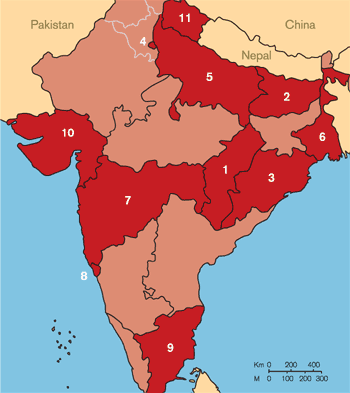|
INDIA REPORT
Operational Factors Targeted
India on course to achieve elimination, with many states also going for goal.
 Up to one-third of reported cases of leprosy in India may be invalid, putting the country closer to the elimination goal than published figures suggest, a meeting of Indian health secretaries heard recently.
The review meeting of health secretaries from 11 endemic states was held in Goa from September 30 to October 1 to go over the progress of leprosy elimination in India and discuss priority action needed to achieve the target by the end of December 2005.
India had a prevalence rate of 2.4 per 10,000 as of March 2004, but if the figure is adjusted to take account of operational factors such as overreporting, wrong diagnosis, re-registration and delayed release from treatment, the PR is closer to 1.4, said Dr. Derek Lobo, Regional Advisor, Leprosy, WHO.
Dr. A.K. Sood, National Institute of Health & Family Welfare, presented the results of Leprosy Elimination Monitoring and Case Validation Studies in India for 2003 and 2004, which indicated that reported prevalence and detection rates were inflated in most states. Wrong diagnosis varied from 3.7% in Chhattisgarh to 19.0% in Madhya Pradesh, re-registered cases were high in Tamilnadu (45.5%), Delhi (36.2%) and Orissa (32.6%) and wrong grouping was high in West Bengal (40.6%) and Madhya Pradesh (39.4%).
Noted Dr. G.P.S. Dhillon, Deputy Director General (Leprosy), Government of India, “We are carrying excess baggage. Why?”
As of March 2004, 17 states/Union Territories had achieved elimination status, with another seven states/UTs very near with a PR of between 1 and 2 per 10,000 population. Nine states have a PR between 2 and 5 and only two states now have a PR of over 5. Seven endemic states contributed 75% of the country's leprosy case load. According to Dr. Dhillon, if these seven states achieved a 25% reduction in cases by the end of 2005, then elimination would be achieved.
Looking at epidemiological factors state by state, an interesting picture emerged. For example, Bihar (which contributes 17% of India's leprosy case load) was among the states complimented for the progress it has made to bring down its PR, despite infrastructure difficulties.
By contrast, apparently better-off states such as Karnataka (PR of 1.52 on December 2003) and Madhya Pradesh (1.65) were a source of worry because their PR has been hovering at the same level for three or four years.
On the drug management side, Dr. Serge Manoncourt, WHO, raised concerns about the ability to provide an uninterrupted supply of drugs to patients by maintaining a three-month buffer stock of MDT at state, district and block levels. Although there is an adequate supply of MDT in the country, he said, the lack of an adequate distribution system was resulting in excesses, shortages and expired supplies at primary and community health centers and at district stores.
In the last 20 years, India has made massive strides in reducing its leprosy burden, with more than 10 million cases cured. Nonetheless, it contributed about 68% of global prevalence and about 80% of new cases worldwide in 2003.
Clearly, there is still work to be done, and it is important to “finish the agenda.”
Attention is now focusing on the district and block level. Ms. Rita Teotia, Joint Secretary (Health), Government of India, said that 174 districts (88 high priority and 86 medium priority) in 14 states/Union Territories, and 836 high endemic blocks (with a PR above 5 per 10,000) had been identified as priority areas and said special initiatives would be taken to address their needs.
Shri J.V.R. Prasada Rao, Secretary (Health), GOI, reasserted the government's full commitment to the National Leprosy Elimination Program, and emphasized the need for intensified supervision, regular monitoring and timely evaluation of each activity until elimination is achieved.
In particular, he stressed that district authorities such as chief medical officers and health officers must be fully involved in the leprosy program in their districts, especially at the block level.
He announced that the government would continue NLEP activities at least until March 2007, even if national elimination is achieved by the end of next year, so as to support states with high case loads in their ongoing elimination efforts.
Prevalence Rates
1. Chhattisgarh |
2000 Mar. |
14 |
2004 Mar. |
6.01 |
|
2. Bihar |
2000 Mar. |
14.7 |
2004 Jun. |
4.5 |
|
3. Orissa |
2000 Mar. |
11.5 |
2004 Aug. |
4.5 |
|
4. Delhi |
2000 Mar. |
3.5 |
2004 Mar. |
3.9 |
|
5. Uttar Pradesh |
2000 Mar. |
6 |
2004 Mar. |
3.5 |
|
6. West Bengal |
2000 Mar. |
5.2 |
2004 Mar. |
3.02 |
|
7. Maharashtra |
2000 Mar. |
3.7 |
2004 Mar. |
2.97 |
|
8. Goa |
2000 Mar. |
3.3 |
2004 Jun. |
1.75 |
|
9. Tamilnadu |
2000 Mar. |
5 |
2004 Mar. |
1.4 |
|
10. Gujarat |
2000 Mar. |
1.8 |
2004 Aug. |
1.25 |
|
11. Uttaranchal |
2001 Mar. |
1.8 |
2004 Jun. |
1.22 |
Note: Partial map of India indicating states represented at the Goa meeting. PR data shown above given by states at the time of the meeting.
|